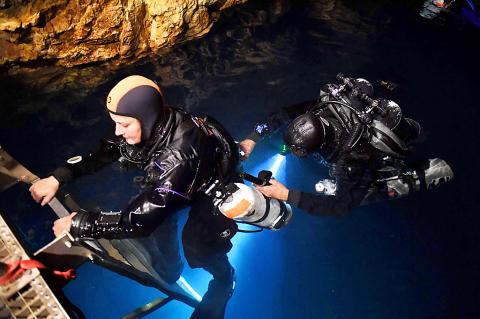Not every diver’s dream is to watch shimmering shoals of fish swim through coral reefs in dazzlingly blue seas.
For Laura Tuominen, the ultimate diving experience is not to be found in the Red Sea or the Caribbean, but in a labyrinth of spectacular underwater caves beneath the pavements of Budapest.
The Hungarian capital is already famous worldwide for its steaming hot spas and thermal baths, but of late, the underwater Janos Molnar cave system, named after the Hungarian pharmacist who discovered it in the 19th century, has become a hot tip for diving aficionados.

Photo: AFP
About 7km in length and previously open only to scientific expeditions, the cave became accessible to the public — that is, qualified divers — when a diving center was opened here in 2015.
“We are under Budapest. It’s amazing,” shouted Tuominen, a 39-year-old Finnish anesthesiologist and passionate amateur diver, as she jumped into the warm waters from a platform mounted in the narrow space at the bottom of the entrance tunnel.
She was one of a group of hobby divers and speleologists, wearing dry suits and carrying double cylinders of compressed gas on their backs, who descended into the gloomy waters, the light from their torches gradually fading out of view.
The group is accompanied by a diving center staff member who directs it with the help of “guideline” cords through the maze of narrow passageways and cavernous cathedral-like chambers.
“It’s the only underwater cave in Budapest open to divers,” said Attila Hosszu, who has run the center since it opened. “Speleology is a niche market. It doesn’t have mass appeal. And our urban location makes us special. It’s very, very rare.”
The advantage of being underneath a city is that “you don’t have to haul your equipment up a mountain or down a deep valley to get here,” Hosszu added.
The entrance to the center is a discreet metal door near one of Budapest’s main boulevards and just a block away from the Danube river, which separates the city’s two halves, Buda and Pest.
According to the diving center’s Web site, the cave was formed many millennia ago, when the geological fault line on which Budapest is situated cracked. The ascending thermal water ate into the rock to create caves close to the surface.
“You can see amazing stalactites and stalagmites in Mexico, but you have to travel for days to get there. Here, you just walk in and dive, it’s very exciting,” 38-year-old Russian traveler Irina Litvinenko said after getting off the tram on her way to the center.
Outside on the streets, the autumn wind was blustery, but inside the center, the air was still warm and humid, making the divers sweat as they prepared their equipment.
Explorations from the 1950s began to reveal the full extent of submerged canyons, halls and passageways, but until the diving center opened three years ago, only scientists were permitted entry to explore or collect samples for laboratory examinations.
Zoltan Bauer, who has been guiding groups through the cave since 2015, said that visitors come mostly for the stunning underwater landscapes.
“There are only a few creatures in the cave,” the 29-year-old said, referring mainly to tiny crustaceans. “But what I really like is the shape of it, how it looks, its beautiful formations.”
Litvinenko, a Cyprus-based finance worker, was similarly entranced.
“Usually, cave diving is about going in and out of a tunnel, but this is like a Swiss cheese, you go down one hole and come back through another,” she said. “For me, it’s super-relaxing. In this technological world, silence is precious.”
The water’s balmy temperature of 20°C to 27°C year-round is another draw, said Marton Illes, a 37-year-old information technology developer from Budapest, who lives nearby.
“This is my 15th dive here, but I’m just scratching the surface. There’s so much to see down there, so many passages,” said Illes, who is a part-time diving instructor.
To preserve the cave’s unique ecosystem, the daily number of divers is limited to 30.
It costs 60 to 140 euros (US$68.47 to US$159.75), depending on the depth of the dive — to a maximum of 90m.
The depth also determines the time limit, which stands at 150 minutes, but no-limit dives might be coming soon.
Geologists, chemists, biologists, and maintenance engineers repairing safety ropes rub shoulders with tourists in the tunnel before a dive.
The “creatures found here cannot be found anywhere else, scientists can study their evolution, and their food and energy sources,” said marine biology and ecology expert David Brankovits, a regular visitor.
As long as tourist divers respect the cave — a protected site since 1982 — there are no concerns about them coming there, he added.

With much pomp and circumstance, Cairo is today to inaugurate the long-awaited Grand Egyptian Museum (GEM), widely presented as the crowning jewel on authorities’ efforts to overhaul the country’s vital tourism industry. With a panoramic view of the Giza pyramids plateau, the museum houses thousands of artifacts spanning more than 5,000 years of Egyptian antiquity at a whopping cost of more than US$1 billion. More than two decades in the making, the ultra-modern museum anticipates 5 million visitors annually, with never-before-seen relics on display. In the run-up to the grand opening, Egyptian media and official statements have hailed the “historic moment,” describing the

‘CHILD PORNOGRAPHY’: The doll on Shein’s Web site measure about 80cm in height, and it was holding a teddy bear in a photo published by a daily newspaper France’s anti-fraud unit on Saturday said it had reported Asian e-commerce giant Shein (希音) for selling what it described as “sex dolls with a childlike appearance.” The French Directorate General for Competition, Consumer Affairs and Fraud Control (DGCCRF) said in a statement that the “description and categorization” of the items on Shein’s Web site “make it difficult to doubt the child pornography nature of the content.” Shortly after the statement, Shein announced that the dolls in question had been withdrawn from its platform and that it had launched an internal inquiry. On its Web site, Le Parisien daily published a

‘NO WORKABLE SOLUTION’: An official said Pakistan engaged in the spirit of peace, but Kabul continued its ‘unabated support to terrorists opposed to Pakistan’ Pakistan yesterday said that negotiations for a lasting truce with Afghanistan had “failed to bring about a workable solution,” warning that it would take steps to protect its people. Pakistan and Afghanistan have been holding negotiations in Istanbul, Turkey, aimed at securing peace after the South Asian neighbors’ deadliest border clashes in years. The violence, which killed more than 70 people and wounded hundreds, erupted following explosions in Kabul on Oct. 9 that the Taliban authorities blamed on Pakistan. “Regrettably, the Afghan side gave no assurances, kept deviating from the core issue and resorted to blame game, deflection and ruses,” Pakistani Minister of

UNCERTAIN TOLLS: Images on social media showed small protests that escalated, with reports of police shooting live rounds as polling stations were targeted Tanzania yesterday was on lockdown with a communications blackout, a day after elections turned into violent chaos with unconfirmed reports of many dead. Tanzanian President Samia Suluhu Hassan had sought to solidify her position and silence criticism within her party in the virtually uncontested polls, with the main challengers either jailed or disqualified. In the run-up, rights groups condemned a “wave of terror” in the east African nation, which has seen a string of high-profile abductions that ramped up in the final days. A heavy security presence on Wednesday failed to deter hundreds protesting in economic hub Dar es Salaam and elsewhere, some